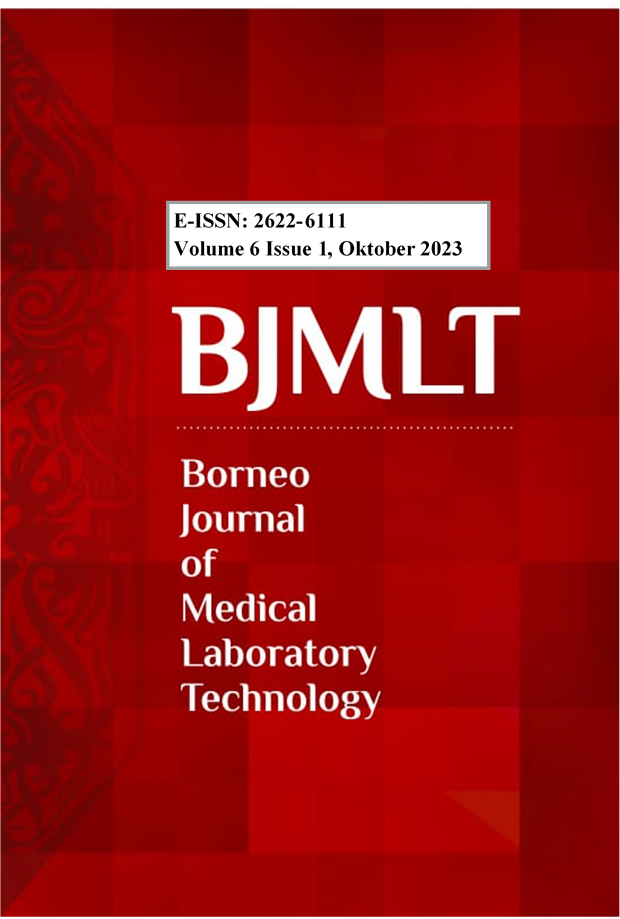Jamur Kontaminan Pada Nasi Berdasarkan Cara Penyimpanan Contaminant Fungus In Rice Based On Storage Method
Main Article Content
Abstract
Rice is a staple food for the people of Indonesia as a source carbohydrate. Improper rice storage can lead to contamination microorganisms. One of these microorganisms is fungus. Contaminant mold is an example of a type of fungus that can grow on foodstuffs such as rice. This study aims to determine the description of fungal contaminants in rice with various kinds of storage, namely rice cooker on, rice cooker off, and serving lid with storage time of 8 hours, 16 hours, and respectively 24 hours. This type of research is a descriptive observational approach cross sectional. The sample uses 3 brands of rice taken from the market Segiri Kota Samarinda with purposive sampling technique. Rice is processed then stored in various places and storage times. After that identification of contaminants macroscopically and microscopically. Data analyzed using univariate analysis. The results of the research show that there is 3 species of contaminating fungi namely Aspergillus sp, Muchor sp, and Penicillium sp. Based on the sample storage with rice cooker on, rice cooker off, and serving cap respectively indicate the percentage growth of the species the same fungus, namely 33.3%.
Downloads
Article Details

This work is licensed under a Creative Commons Attribution-ShareAlike 4.0 International License.
All rights reserved. This publication may be reproduced, stored in a retrieval system, or transmitted in any form or by any means, electronic, mechanical, photocopying, recording.
References
Alexopoulus, M. (2012). Hakikat Sentra Jamur Sebagai Wahana Rekreasi Dan Edukasi Jamur Di Yogyakarta Melalui Transformasi Morfologi Jamur. Jurnal Mikologi, 1(1), 11–30.
Aminudin, M., & Habib, I. (2009). Pengaruh Lamanya Penyimpanan terhadap Pertumbuhan Bakteri pada Nasi yang dimasak di Rice Cooker dengan Nasi yang Dikukus The Influence of Storage Duration on Bacterial Growth. Mutiara Medika, 9, 18–22.
Ariyadi, T., & Anggraini, H. (2010). Penetapan Kadar Karbohidrat Pada Nasi Aking Yang Dikonsumsi Masyarakat Desa Singorojo Kabupaten Kendal. Prosiding Seminar Nasional UNIMUS, 18, 2–4.
Bakri, B., Intiyati, A., & Widartika. (2017). Sistem Penyelenggara Makanan Institusi.
cfns. (2020). Bahaya Cemaran Mikotoksin dan Kimia pada Bahan Pangan. Pusat Studi Pangan Dan Gizi Universitas Gadjah Mada.
Chan, F., Kurniawan, A. R., Kalila, S., Amalia, F., Apriliani, D., & Herdana, S. V. (2019). the Impact of Bullying on the Confidence of Elementary School Student. Jurnal Pendas Mahakam, 4(2) 152–157.
Dewi, R., Nursanty, R., & Yulvizar, C. (2010). The Effect Of Storage Time On Total Of Fungi In Kanji Pedah. Jurnal Natural, 1(2), 74–78.
Dwi Wini et al. (2017). Identifikasi Jamur Pada Nasi Kuning. Politeknik Kesehatan Kementeian Kesehatan Semarang.
Edyansyah, E. (2016). Keberadaan Jamur Kontaminan pada Kacang Tanah (Bumbu Gado-gado) yang Dijual Pedagang di Kota Palembang Tahun 2015. Jurnal Kesehatan, XI(1), 127–135.
Gandjar, I. dkk. (2006). Mikologi Dasar dan Terapan (Revisi). Yayasan Pustaka Obor Indonesia.
Hapsari, A. (2014). isolasi dan Identifikasi fungi pada Ikan Maskoki di Bursa ikan hias gunung sari surabaya. Studi, Program Perairan, S- Budidaya.
Haryadi. (2006). Teknik Pengolahan Beras. Gadjah Mada University Press.
Haryono, M. (2011). Kandungan Nutrisi Nasi Putih Dilihat dari Proses Pengolahannya. Institut Pertanian Bogor. 38
Hasanah, U. (2017). Mengenal Aspergillosis, Infeksi Jamur Genus Aspergillus. Jurnal Keluarga Sehat Sejahtera, 15(2), 76–86.
Ika, P., & Hidayati. (2016). Diktat Mikrobiologi Dasar. Universitas Kanjuruan Malang, 115. repository.unikama.ac.id/656/1/Buku Ajar Mikrobiologi.pdf
Indraswati, D. (2016). Kontaminasi Makanan (Food Contamination) oleh Jamur. In Forum Ilmiah Kesehatan ( FORIKES ).
Indriana, N. (2019). Yuk, Kenali Berasmu! Mediakom Kemenkes.
Kustyawati, M. E. (2009). Study on the Role of Yeast in Tempe Production. 29(2).
Notoatmojo, S. (2020). Metodologi Penelitian Kesehatan. PT. Asdi Mahasatya.
Órdova, C., Oussos, S. R., Aratti, J. B., Ungaray, J. N., & Oera, O. L. (2003). Thermotolerant Fungal Isolates. Culture, 15(2), 37–44.
Pane, L. (2021). 12 Jenis Jamur Kontaminan.
Pittara. (2023). Penyakit Jamur Hitam. Alodokter.
Rahamdetiassani, A. et al. (2011). Morfologi Makroskopis dan Mikroskopis Fungi. Universitas Nasional Jakarta.
Raju, S. ., & Rajappa, S. (2011). Isolation and Identification of Candida from the Oral Cavity. ISRN Dentistry, 2011(Table 2), 1–7.
Rakhmawati, A. (2013). Reproduksi Jamur. In Universitas Negeri Yogyakarta (Issue 12).
Rinaldi, S. F., & Mujianto, B. (2017). Metode Penelitian dan Statistik (Pertama). Kementerian Kesehatan Republik Indonesia.
Ristiari, N. P. N., Julyasih, K. S. M., & Suryanti, I. A. P. (2018). Isolasi dan identifikasi jamur mikroskopis pada rizosfer tanaman jeruk siam (Citrus nobilis Lour.) di Kecamatan Kintamani, Bali. Jurnal Pendidikan Biologi Undiksha, 6(1), 10–19.
Rosyidhana, Z. (2020). Mengenal Cemaran Mikotoksin Pada Produk Hasil Pertanian. DPKP DIY, 1.
Sanjaya, Y., Nurhaeni, H., & Halima, M. (2010). Isolasi, Identifikasi, dan Karakterisasi Jamur Entomopatogen dari larva Spodoptera litura (Fabricius). Bionatura-Jurnal Ilmu-Ilmu Hayati Dan Fisik, 12(3), 136–141.
Sarni. (2017). Sistem Penyimpanan Bahan Makanan Di TOM’S Cafe Tembilahan Kabupaten Indragiri Hilir Provinsi Riau. Jurnal Jom Fisip, 4(2), 1689–1699. 39
Sopandi, T., & Wardah. (2014). Mikrobiologi Pangan: Teori Dan Praktik. ANDI Yogyakarta.
Stekom, U. (2022). Penicillium Digitatum. Ensiklopedia Dunia.
Stikes Husada Borneo. (2022). Kenali Kandungan Gizi Nasi dan Manfaatnya untuk Tubuh. Admisi Husada Borneo.
Sugiyono. (2010). Metode penelitian kuantitatif dan kualitatif dan R&D. Alfabeta Bandung.
Suherlan, R. (2022). Cara Mencuci Beras dengan Baik dan Benar, Ini Alasannya. Kontan.Co.Id.
Sulastina, N. A. (2020). Analisis Jamur Kontaminan Pada Roti Tawar Yang Dijual
Di Pasar Tradisional. Jurnal ’Aisyiyah Medika, 5(1), 122–130.
Supriyanto, & Sulistyowati, H. (2011). Pengembangan PGPF Menjadi Pupuk Pestisida. J. Tek. Perkebunan & PSDL, 1, 19–27.
Suryani, Y., Taupiqurrahman, opik, & Kulsum, yuni. (2020). Mikologi. Freeline Cipta Granesia MIKOLOGI.
Tim Promkes RSST. (2022). Aspergilosis. Kementerian Kesehatan Direktorat Jenderal Pelayanan Kesehatan.
Wahyuni, D. (2011). Buku Ajar Mikologi Dasar. Jember University Press, 27
